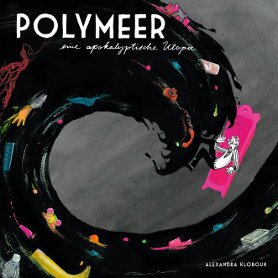Children's Books
Alexandra Klobouk
POLYMEER. Eine apokalyptische Utopie
[The plastic sea. An apocalyptic utopia]
Alexandra Klobouk
POLYMEER. Eine apokalyptische Utopie
[The plastic sea. An apocalyptic utopia]
This book was showcased during the special focus on Russian (2012 - 2014).
Review
A massive wave of black water dotted with lurid fragments of plastic rubbish seizes hold of a man clinging to a pink cupboard and threatens to engulf him. This wave on the cover of Alexandra Klobouk’s non-fiction picture book draws us into a story recounted with very few words. The year is 2043AD. The poles have melted, Holland is disappearing beneath the sea. The last remaining Dutchman, swept off a lighthouse by a tsunami, drifts off into the open sea perched on a cupboard and surrounded by tins, tubes, vacuum cleaners, telephones and plastic ducks. After two months in the water, surviving thanks to the carpet of plastic rubbish, the man — a postgraduate student — is rescued and evacuated to Switzerland along with his countrymen. But the Dutchmen aren’t happy living amongst mountains: they want to live by the sea, and start doing research on plastic magnetism. As a result, thanks to their vision and energetic application, the apocalypse experienced by the protagonist and all the other survivors turns into a utopia — but one with feet of clay. The pulverised rubbish — some one hundred million tons of plastic — is compacted into a new continent thanks to the magnetism discovered by the researchers, and rendered habitable. The Seventh Continent, a utopian realm. The homeless Dutchmen can make a new life here. Life on a carpet of plastic? The outcome is far from utopian.
The artist Alexander Kobouk decided to research the topic of ‘water’: “Things very rapidly went in a political direction, water being a highly political issue. In the course of my investigations I came across the fact that there is a huge gyre of plastic in the North Pacific. That sounded to me like science fiction, and it seemed to me that — taken together with other facts that sound like science fiction, such as the melting of the polar icecaps, the rise in sea levels, the ultimate disappearance of Holland and other low-lying countries — the whole palaver is the sort of story that could have been dreamt up in the 60s. So I very quickly hit on the idea of a plastic continent, and imagined it as being invented by a Dutchman, since the Dutch are an ingenious lot, and are already wondering about their future.”
But is it really possible to dream up some invention that would stop the sea being polluted and stop birds and fish dying on a massive scale as a result of it? This fact-based picture book can’t give any answers, but it makes its readers think and offers some memorable pointers; despite the seriousness of its subject matter it makes us smile, and concludes with two pages of facts that leave a lasting impression on the reader, and ideally should jolt each and every one of us into changing our behaviour.
Alexandra Klobouk’s illustrations are for the most part double-page collages, except for one double page where the action is fast-forwarded by means of eighteen successive mini-images. Paintings and drawings, acrylics and inks are combined with images of plastic objects cut from catalogues and junk mail, all glued on top of one another. Though black and white is its basic colour scheme, the book becomes steadily more colourful, more lurid, more neon-lit, since each image contains more multi-coloured plastic than its predecessor. Even so, however, the story’s sombre, menacing mood of destruction persists throughout, reflected especially in the blackness and wildness of the sea.
So is “Polymeer” a utopia, a dystopia, or — as the sub-title puts it — an ‘apocalyptic utopia’?
We have the verdict of Alexandra Klobouk herself: “The story appears to be ending happily with the creation of a utopia — but ultimately it all falls apart, and people’s hopes come to nothing. If the story has a moral, then it’s this: there are no easy answers to the problem.”
“Polymeer” is a story about marine pollution that is fact-based, socially engaged, extremely interesting — and amusing, too.
This is a genre-bending book with universal appeal.
Translated by John Henry Eagle
By Ute Wegmann
Ute Wegmann, born 1959 in Düsseldorf, obtained an MA in French Studies, German Studies and Education at Cologne University, and works as a literary critic, freelance writer and radio producer and presenter. She lives in Cologne.
(Updated: 2020)


